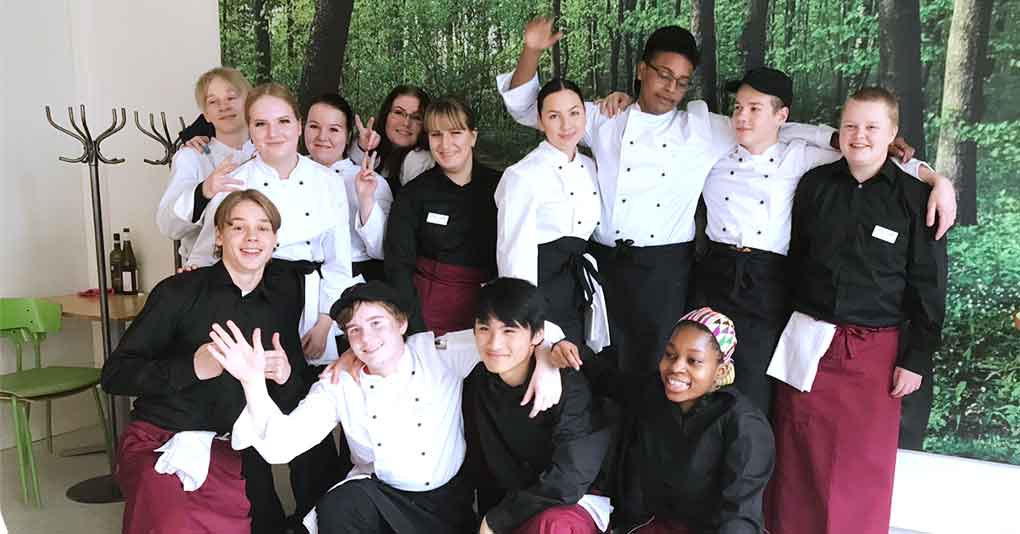Responsible restaurant sector
The professional ethics in the restaurant and catering business consists of respecting the customer, equal treatment of all people, equal service, and confidentiality of customer relationship.

Responsibility in the restaurant business means that the operation is sustainable ecologically, socially and financially.
Responsible restaurant businesses strive to continuously improve their resource efficiency and to minimise adverse environmental impacts. It looks after the well-being of its staff and acts responsibly towards its stakeholder groups.
It is crucial in terms of ecological and financial sustainable development that the restaurant business pays attention to the environmental impact of food, savings in materials and energy, also attempting to minimise the amount of waste. Customer service must take into account that customers are more and more environmentally conscious and want to know about environmental and safety issues.
Responsible restaurant professional
The professionals appreciate their own work and that of others and also the national culture and cultural diversity. They also feel a responsibility about their customers, safety, environment, co-workers, and continuously strive to become better. The professional ethics in the restaurant business consists of respecting the customer, equal treatment of all people, equal service, and confidentiality of customer relationship.
The circular economy in the restaurant business
The starting point with the circular economy is to save natural resources and to reduce waste. It is a more comprehensive concept than just recycling. The circular economy is a new economic model that emphasises intangible consumption and services. For example, instead of buying items, they can be obtained for use through various digital distribution services.
Since the world’s natural resources are limited and the world’s population is growing, entirely new solutions are needed to satisfy people’s material needs. In a circular economy, energy is produced by renewable means and products are designed to last longer. The raw materials and materials needed for them can be re-used. This reduces the need for new materials, and less waste is created, because any excess material can be used as raw material by other producers.
The circular economy can be put into use in the restaurant business for example by
- Composting via waste and recycling nutrients
- Reducing food wastage and utilising waste food
- Shortening the transport chain and reducing packaging/using durable packaging
- Recovering and utilising waste heat for heating premises
- Making smart purchases, such as workwear and furniture make from recycled materials.
Environmentally friendly operation in commercial kitchens
Environmental load in food services can be reduced for example by
- Using raw materials that have low environmental impacts
- Reducing food wastage during storage, preparation, presentation and on plates
- Reducing energy, water and chemical consumption in the kitchen
- Reducing waste creation and transport
- Guiding customers to select environmentally friendly meals.
Video: Professional kitchen’s ABC: Sustainable development
Environmentally friendly food and menu planning
Food has major environmental impacts. What we eat affects air and water quality, biodiversity, the wellbeing of farm animals, and the social and financial sustainability of food production. The environmental impact of food is created largely during food production, but transportation and food waste also cause environmental impacts and carbon dioxide emissions. Commercial kitchens can affect primary food production and processing through responsible raw material choices, that is, purchasing. This means that menu planning has a major indirect effect.
The following principles should be followed in menu planning
- Increase the amount of vegetables
- Use legumes in particular as sources of protein
- Reduce meat and dairy products
- Favour organic raw materials
- Favour domestic role materials and locally produced goods
- Use seasonal products
- Pay attention to the shelf life of raw materials
- Favour raw materials that have a short production chain and lower level of processing
- Plan the menu cycle in a way that raw materials can be used for the following meals.
Discarded food
The environmental impact of discarded food has become a global concern. Fortunately each restaurant professional can help reduce it. The first step in reducing waste is to weigh and monitor it. You have to know where and how much waste is created and what type it is. Based on the weighing results, you can address the reasons for it and subsequently reduce waste.
Various applications are available for measuring waste. You enter into the application every day what has been thrown out and why. The application will help to visualise how the amount of waste has developed and then plan measures to reduce it.
Restaurant Perho starting using the Hävikkimestari app in autumn 2018. It makes it easy to measure food waste in restaurants. The app not only helps to accumulate information, the idea is that the information is used to reduce food waste in the future. The app was also introduced in the teaching kitchens of the Töölö campus in January 2019.
Ensuring safety is also an element of responsibility
Restaurants have many occupational accidents. Accident risk is increased by sharp, cutting, mixing or crushing tools and machines. Hot tools, food and steam increase the risk of burns. Fat, liquid and dirt on the floor may cause people to slip and fall. Intoxicated customers may lead to violence and problems with cleanliness and order.
Taking care of safety issues is an important part of responsibility in the restaurant business. Safety is related to employees, the environment, data, property and products. Particular attention must be paid to prevent fires and problem situations. The best way to prevent safety problems is to follow safety instructions, keep the premises clean and use common sense.
How can I contribute to safety?
- I read the safety instructions and follow them
- I keep the premises clean and orderly throughout my shift
- I put items back to their places once I am finished using them
- I get any rubbish, water and grease stains off the floor
- I make sure that the machines and equipment I use are in working order
- I switch off the power before unplugging machines
- I wash knives immediately after use

